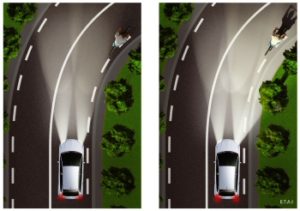We’ve all been there. A dark night, a sharp bend, and a pedestrian wearing dark clothes hiding in the shadows. If only there was some way that the headlights could ‘see round the corner’, like the driver tries to…

When introduced in the mid-2000s, the Citroën C4 and C6 shared a “new” feature with the facelifted Mk1 C5 – headlights that swivel with the steering, to light the inside of a bend and allow the driver to see where his eyes are looking instead of just dead ahead. Clever idea?
This is how Citroën’s C5 information describes it:
Xenon dual-function directional headlamps for clear vision
The Citroën C5 is the first Marque vehicle to feature Xenon dual-function directional headlamps.
Fitted as standard with the Exclusive trim, the electronically controlled Xenon dual-function directional headlamps provide improved lighting for cornering. As soon as the driver starts to take a bend, sensors analyse the degree to which the wheels are turned, using the steering wheel position. To optimise the lighting of the road ahead, the headlamps pivot horizontally over an angle of around 15° to the right or to the left (8° for the headlamp on the outside of the bend and up to 15° for the headlamp on the inside). Lighting up areas that were previously in darkness, these smart headlamps clearly improve visibility at night or in bad weather and allow the driver to see the road conditions, as well as to distinguish other road users and possible obstacles – an important advantage in terms of safety.
Specifically, the directional headlamps of the new C5 feature an elliptical bi-xenon directional headlamp, active in both the low-beam and high-beam positions, and a long-range complex-shape halogen completing the high-beam function for excellent visibility.
 However, there’s something in there that the marketing people forget to mention. Sure, Xenon directional headlights are new – but not that new – after all, Xenon lights were available on the pre-facelift C5. So it must be the directional headlights that are new?
However, there’s something in there that the marketing people forget to mention. Sure, Xenon directional headlights are new – but not that new – after all, Xenon lights were available on the pre-facelift C5. So it must be the directional headlights that are new?
Not so! They were available on higher specification DS models from 1967 and were fitted to all SMs except for US-spec cars. However, on the DS and SM, it was only driving lights that worked with high beam that steered, rather than dip as well – and that’s a very useful addition to the technology for modern road conditions where main beam can rarely be used.
The current system only pivots to 15°, however, unlike the 80° of the original DS system. At speed, this will make no difference, but at low speed and large amounts of lock – such as a hairpin bend or a gate – it will make a BIG difference.
The main difference, however, between original and current systems is in the actuation. On the original DS and SM system, the steering was connected to the lights by a system of wires and rods. On the re-invented system it is, naturally, computer controlled.


